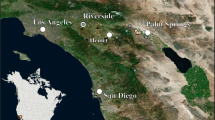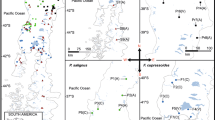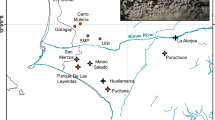Abstract
Pedicularis dudleyi (Dudley’s Lousewort, Orobanchaceae) is an extremely rare plant endemic to the redwood forests of Central California. Until recently, the species was known only from three extant natural populations. However, in 2019, one of those populations was described as a novel species (P. rigginsiae D.J. Keil) based on morphological and ecological data leaving only two populations described as P. dudleyi. While little is known about the past distribution of the species, historical records have led to speculation that the species was once more widespread and may have suffered from habitat destruction as a result of widespread logging during the early twentieth century. We utilized a combination of ddRAD SNP and Sanger sequencing data to: (1) Test the morphological hypothesis that P. rigginsiae is distinct from P. dudleyi; (2) Describe the genetic diversity and population structure of P. dudleyi and; (3) Test the hypothesis that the species underwent a bottleneck corresponding with increased logging of redwood forests in the early twentieth century. Our results support the recognition of P. rigginsiae as distinct from P. dudleyi, increasing the conservation priority of both species. Genetic diversity statistics and analyses of genetic structure suggest that both populations of P. dudleyi are highly differentiated from each other with one population exhibiting unexpected substructure. Finally, demographic modeling supports a scenario where the contemporary rarity of the species is explained by a recent bottleneck.





Similar content being viewed by others
References
Allendorf FW (1986) Genetic drift and the loss of alleles versus heterozygosity. Zoo Biology 5:181–190. https://doi.org/10.1002/zoo.1430050212
Anagnostakis SL (1987) Chestnut blight: the classical problem of an introduced pathogen. Mycologia 79:23–37. https://doi.org/10.1080/00275514.1987.12025367
Barrett SC, Kohn JR (1991) Genetics and conservation of rare plants. Genetic and evolutionary consequences of small population size in plants: Implications for conservation. Oxford University Press, New York, pp 3–30
Bellard C, Cassey P, Blackburn TM (2016) Alien species as a driver of recent extinctions. Biol Let 12:20150623. https://doi.org/10.1098/rsbl.2015.0623
Booy G, Hendriks RJ, Smulders MJ, Van Groenendael JM, Vosman B (2000) Genetic diversity and the survival of populations. Plant Biol 2:379–395. https://doi.org/10.1055/s-2000-5958
Borowiec ML (2016) AMAS: a fast tool for alignment manipulation and computing of summary statistics. PeerJ 4:e1660. https://doi.org/10.7717/peerj.1660
Breiman L (2001) Random forests. Mach Learn 45:5–32. https://doi.org/10.1023/A:1010933404324
Brown JH (1984) On the relationship between abundance and distribution of species. Am Nat 124:255–279. https://doi.org/10.1086/284267
California Native Plant Society, Rare Plant Program (2021) Inventory of Rare and Endangered Plants of California (online edition, v9–01 0.0). Available from https://www.rareplants.cnps.org. Accessed Jun 22, 2021).
California Department of Fish and Wildlife (CDFW) (2021) State and Federally Listed Endangered, Threatened, and Rare Plants of California.
Collin FD, Durif G, Raynal L, Lombaert E, Gautier M, Vitalis R, Marin JM, Estoup A (2021) Extending approximate bayesian computation with supervised machine learning to infer demographic history from genetic polymorphisms using DIYABC random forest. Mol Ecol Resour 00:1–16. https://doi.org/10.1111/1755-0998.13413
Crnokrak P, Barrett SC (2002) Perspective: purging the genetic load: a review of the experimental evidence. Evolution 56:2347–2358. https://doi.org/10.1554/0014-3820(2002)056[2347:PPTGLA]2.0.CO;2
Daly DC, Fine PV (2011) A new Amazonian section of Protium (Burseraceae) including both edaphic specialist and generalist taxa. Studies in neotropical Burseraceae XVI. Syst Bot 36:939–949. https://doi.org/10.1600/036364411X604958
Danecek P, Auton A, Abecasis G, Albers CA, Banks E, DePristo MA, Handsaker RE, Lunter G, Marth GT, Sherry ST, McVean G (2011) The variant call format and VCF tools. Bioinformatics 27:2156–2158. https://doi.org/10.1093/bioinformatics/btr330
Drummond AJ, Ashton B, Buxton S, Cheung M, Cooper A, Heled J, Kearse M, Moir R, Stones-Havas S, Sturrock S, Thierer T, Wilson A (2010) Geneious v5.3.3. Biomatters Ltd, Auckland, New Zealand
Earl DA, vonHoldt BM (2012) STRUCTURE HARVESTER: a website and program for visualizing STRUCTURE output and implementing the Evanno method. Conserv Genet Resour 4:359–361. https://doi.org/10.1007/s12686-011-9548-7
Ellstrand NC, Elam DR (1993) Population genetic consequences of small population size: implications for plant conservation. Annu Rev Ecol Syst 24:217–242. https://doi.org/10.1146/annurev.es.24.110193.001245
Evanno G, Regnaut S, Goudet J (2005) Detecting the number of clusters of individuals using the software STRUCTURE: a simulation study. Mol Ecol 14:2611–2620. https://doi.org/10.1111/j.1365-294X.2005.02553.x
Fernández M, Hamilton HH, Kueppers LM (2015) Back to the future: using historical climate variation to project near-term shifts in habitat suitable for coast redwood. Glob Change Biol 21:4141–4152. https://doi.org/10.1111/gcb.13027
Foll M, Gaggiotti O (2008) A genome-scan method to identify selected loci appropriate for both dominant and codominant markers: a Bayesian perspective. Genetics 180:977–993. https://doi.org/10.1534/genetics.108.092221
Frankham R (2005) Genetics and extinction. Biol Cons 126:131–140. https://doi.org/10.1016/j.biocon.2005.05.002
Frankham R, Gilligan DM, Morris D, Briscoe DA (2001) Inbreeding and extinction: effects of purging. Conserv Genet 2:279–284. https://doi.org/10.1023/A:1012299230482
Gaston KJ, Lawton JH (1990) Effects of scale and habitat on the relationship between regional distribution and local abundance. Oikos 58:329–335. https://doi.org/10.2307/3545224
AK Gujral TM Misiewicz C Hauser B Carter In press Natural history and demography of the imperiled redwood forest specialist Pedicularis dudleyi (Dudley’s Lousewort, Orobanchaceae). Madroño
Habel JC, Schmitt T (2012) The burden of genetic diversity. Biol Cons 147:270–274. https://doi.org/10.1016/j.biocon.2011.11.028
Habel JC, Zachos FE, Finger A, Meyer M, Louy D, Assmann T, Schmitt T (2009) Unprecedented long-term genetic monomorphism in an endangered relict butterfly species. Conserv Genet 10:1659. https://doi.org/10.1007/s10592-008-9744-5
Hagen M, Wikelski M, Kissling WD (2011) Space use of bumblebees (Bombus spp.) revealed by radio-tracking. PloS one 6:e19997. https://doi.org/10.1371/journal.pone.0019997
Hanski I (1982) Dynamics of regional distribution: the core and satellite species hypothesis. Oikos 38:210–221. https://doi.org/10.2307/3544021
Hanski I, Gyllenberg M (1993) Two general metapopulation models and the core-satellite species hypothesis. Am Nat 142:17–41. https://doi.org/10.1086/285527
Holsinger KE, Weir BS (2009) Genetics in geographically structured populations: defining, estimating and interpreting FST. Nat Rev Genet 10:639–650. https://doi.org/10.1038/nrg2611
Jakobsson M, Rosenberg NA (2007) CLUMPP: a cluster matching and permutation program for dealing with label switching and multimodality in analysis of population structure. Bioinformatics 23:1801–1806. https://doi.org/10.1093/bioinformatics/btm233
Jennings H, Wallin K, Brennan J, Del Valle A, Guzman A, Hein D, Hunter S, Lewandowski A, Olson S, Parsons H, Scheidt S (2016) Inbreeding, low genetic diversity, and spatial genetic structure in the endemic Hawaiian lobeliads Clermontiafauriei and Cyaneapilosa ssp. longipedunculata. Conserv Genet 17:497–502. https://doi.org/10.1007/s10592-015-0785-2
Jombart T (2008) adegenet: a R package for the multivariate analysis of genetic markers. Bioinformatics 24:1403–1405. https://doi.org/10.1093/bioinformatics/btn129
Katoh K, Standley DM (2013) MAFFT multiple sequence alignment software version 7: improvements in performance and usability. Mol Biol Evol 30:772–780. https://doi.org/10.1093/molbev/mst010
Keil DJ (2019) Pedicularis rigginsiae (Orobanchaceae), a new species from an area of botanical endemism in central-coastal California. Phytoneuron 2:1–8
Kreyer D, Oed A, Walther-Hellwig K, Frankl R (2004) Are forests potential landscape barriers for foraging bumblebees? Landscape scale experiments with Bombus terrestris agg. and Bombus pascuorum (Hymenoptera, Apidae). Biol Cons 116:111–118. https://doi.org/10.1016/S0006-3207(03)00182-4
Liu D, Zhang L, Wang J, Ma Y (2020) Conservation genomics of a threatened Rhododendron: contrasting patterns of population structure revealed from neutral and selected SNPs. Front Genet 11:757. https://doi.org/10.3389/fgene.2020.00757
Maschinski J, Albrecht MA (2017) Center for plant conservation’s best practice guidelines for the reintroduction of rare plants. Plant Diversity 39:390–395. https://doi.org/10.1016/j.pld.2017.09.006
Meirmans PG, Van Tienderen PH (2004) GENOTYPE and GENODIVE: two programs for the analysis of genetic diversity of asexual organisms. Mol Ecol Notes 4:792–794. https://doi.org/10.1111/j.1471-8286.2004.00770.x
Meyer M, Kircher M (2010) Illumina sequencing library preparation for highly multiplexed target capture and sequencing. Cold Spring Harb Protoc 6:prot5448
Milano ER, Mulligan MR, Rebman JP, Vandergast AG (2020) High-throughput sequencing reveals distinct regional genetic structure among remaining populations of an endangered salt marsh plant in California. Conserv Genet 21:547–559. https://doi.org/10.1007/s10592-020-01269-3
Nei M (1987) Molecular evolutionary genetics. Columbia University Press. https://doi.org/10.7312/nei-92038
Oostermeijer JGB, Van Eijck MW, Den Nijs JCM (1994) Offspring fitness in relation to population size and genetic variation in the rare perennial plant species Gentiana pneumonanthe (Gentianaceae). Oecologia 97:289–296. https://doi.org/10.1007/BF00317317
Oostermeijer JGB, Berholz A, Poschlod P (1996) Genetical aspects of fragmented plant populations. In: Settele J, Margules C, Poschlod P, Henle K (eds) Species survival in fragmented landscapes. Springer, Dordrecht, pp 93–101
Osborne JL, Martin AP, Carreck NL, Swain JL, Knight ME, Goulson D, Hale RJ, Sanderson RA (2008) Bumblebee flight distances in relation to the forage landscape. J Anim Ecol 77:406–415. https://doi.org/10.1111/j.1365-2656.2007.01333.x
Paris JR, Stevens JR, Catchen JM (2017) Lost in parameter space: a road map for stacks. Methods Ecol Evol 8:1360–1373. https://doi.org/10.1111/2041-210X.12775
Peterson BK, Weber JN, Kay EH, Fisher HS, Hoekstra HE (2012) Double digest RADseq: an inexpensive method for de novo SNP discovery and genotyping in model and non-model species. PloS one 7:e37135
Pritchard JK, Stephens M, Donnelly P (2000) Inference of population structure using multilocus genotype data. Genetics 155:945–959. https://doi.org/10.1111/j.1471-8286.2007.01758.x
Reed DH, Frankham R (2003) Correlation between fitness and genetic diversity. Conserv Biol 17:230–237. https://doi.org/10.1046/j.1523-1739.2003.01236.x
Rizzo DM, Garbelotto M (2003) Sudden oak death: endangering California and Oregon forest ecosystems. Front Ecol Environ 1:197–204. https://doi.org/10.1890/1540-9295(2003)001[0197:SODECA]2.0.CO;2
Robart BW, Gladys C, Frank T, Kilpatrick S (2015) Phylogeny and biogeography of North American and Asian Pedicularis (Orobanchaceae). Syst Bot 40:229–258
Rochette NC, Catchen JM (2017) Deriving genotypes from RAD-seq short-read data using Stacks. Nat Protoc 12:2640–2659. https://doi.org/10.1600/036364415X686549
Rochette NC, Rivera-Colón AG, Catchen JM (2019) Stacks 2: analytical methods for paired-end sequencing improve RADseq-based population genomics. Mol Ecol 28:4737–4754. https://doi.org/10.1111/mec.15253
Rosenberg NA (2004) DISTRUCT: a program for the graphical display of population structure. Mol Ecol Notes 4:137–138. https://doi.org/10.1046/j.1471-8286.2003.00566.x
Shaw J, Lickey EB, Beck JT, Farmer SB, Liu W, Miller J, Siripun KC, Winder CT, Schilling EE, Small RL (2005) The tortoise and the hare II: Relative utility of 21 noncoding chloroplast DNA sequences for phylogenetic analysis. Am J Bot 92:142–166. https://doi.org/10.3732/ajb.92.1.142
Slatkin M (1987) Gene flow and the geographic structure of natural populations. Science 236:787–792. https://doi.org/10.1126/science.3576198
Spielman D, Brook BW, Frankham R (2004) Most species are not driven to extinction before genetic factors impact them. Proc Natl Acad Sci 101:15261–15264. https://doi.org/10.1073/pnas.0403809101
Sprague E (1962) Parasitism in Pedicularis. Madroño 16:192–200
Sprague E (1959) Ecological Life History of California species of Pedicularis. PhD Dissertation, Claremont Graduate School, Claremont, CA.
Stamatakis A (2014) RAxML version 8: a tool for phylogenetic analysis and post-analysis of large phylogenies. Bioinformatics 30:1312–1313. https://doi.org/10.1093/bioinformatics/btu033
Stebbins GL (1979) Rare species as examples of plant evolution. Great Basin Naturalist Memoirs 3:113–117
Taylor SS, Jamieson IG (2008) No evidence for loss of genetic variation following sequential translocations in extant populations of a genetically depauperate species. Mol Ecol 17:545–556
Tilman D, May RM, Lehman CL, Nowak MA (1994) Habitat destruction and the extinction debt. Nature 371:65–66. https://doi.org/10.1038/371065a0
Acknowledgements
We thank Abigail Moore and Leann Monaghan, Christine Edwards and two anonymous reviewers for their insightful comments on the manuscript. We also thank Lydia Smith, Austin Betancourt, Anjum Gujral, and Tracey Simmons for their invaluable assistance in the laboratory and field. The study benefited from the insights and logistics assistance of Portola Redwoods State Park staff Tyler Knapp, Ryan Diller, Tim Hyland and Joanne Kerbavaz. We are also grateful to Mujtaba Ghouse (Portola and Castle Rock Foundation) and Amy Patten (California Native Plant Society) for their valuable discussion and Kim Kuska, who shared many of his observations and insights with us. The computing for this project was performed at the OU Supercomputing Center for Education & Research (OSCER) at the University of Oklahoma (OU).
Funding
This study was funded through Research Grant #144 from Save the Redwoods League and the National Postdoctoral Research Fellowship in Biology Award #1810989.
Author information
Authors and Affiliations
Contributions
TMM, CH and BEC designed the study. TMM gathered and analyzed the data and wrote the manuscript. CH and BEC provided guidance on the study and commented on all drafts of the manuscript.
Corresponding author
Ethics declarations
Conflict of interest
The authors have no conflict of interest.
Data availability
Raw sequence data were deposited at the National Center for Biotechnology Information Short Read Archive (http://www.ncbi.nlm.nih.gov/sra/) database under the accession number BioProject ID PRJNA742774. Processed SNP data (vcf, genepop, STRUCTURE and DIYABC-RF formats) and the concatenated ITS and matK-5’trnK intron sequence alignment are available from DataDryad (https://doi.org/10.6078/D1S415). Genbank accession numbers for the ITS and matK-5’trnK intron are listed in Table 1.
Code availability
Not Applicable.
Additional information
Publisher's Note
Springer Nature remains neutral with regard to jurisdictional claims in published maps and institutional affiliations.
Supplementary Information
Below is the link to the electronic supplementary material.
Rights and permissions
About this article
Cite this article
Misiewicz, T.M., Hauser, C. & Carter, B.E. Population genetics, demographic and evolutionary history of the Dudley’s lousewort (Pedicularis dudleyi), a rare redwood forest specialist. Conserv Genet 23, 513–525 (2022). https://doi.org/10.1007/s10592-022-01433-x
Received:
Accepted:
Published:
Issue Date:
DOI: https://doi.org/10.1007/s10592-022-01433-x




